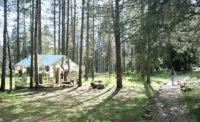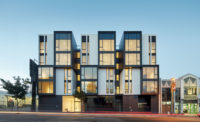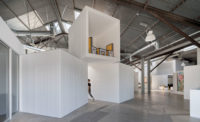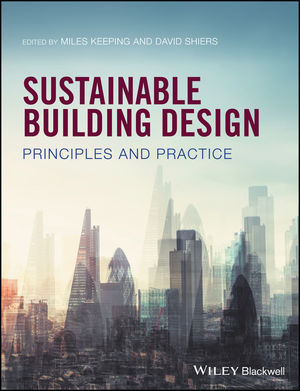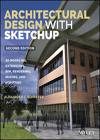Design Vanguard 2017: David Kohn Architects
London

Quad, New College, Oxford
The architect’s new quad includes student housing as well as facilities for the adjacent New College School, a lecture theater and a music hall. The curved limestone facade of the student housing is punctuated with fixed windows flanked by anodized aluminum ventilation panels.
Image courtesy David Kohn Architects

Sanderson House
A 2014 brick addition to a 19th-century Victorian house in London was designed to feel like a pergola that connects its new kitchen and dining room to the garden. An arched window offers views and transmits borrowed light into the living room of the original house.
Photo © Will Pryce

A Room for London
Commissioned by Living Architecture and Artangel, and designed with the artist Fiona Banner, A Room for London—a boat-shaped structure perched atop Queen Elizabeth Hall at London’s Southbank Centre—was created as a residence for visiting artists, writers, and musicians during London’s 2012 Olympic year.
Photo © Charles Hosea

Greenwich Design District
For London’s new Greenwich Design District, DKA and seven other firms (including local 6A Architects and Madrid’s SelgasCano) have each designed a pair of buildings for creative studios. DKA’s brick and glass-block designs are covered with green grids, a reference to the work of James Stirling.
Image courtesy David Kohn Architects

Stable Acre
For a three-bedroom weekend house in the English county of Norfolk, DKA created a narrow structure that conforms to the footprint of the 19th-century stable that once occupied the site. The "tentlike" living room has a south-facing wall of glass doors that can open completely to the garden and views beyond.
Photo © Will Pryce





Architects & Firms
A few years ago, David Kohn, who founded David Kohn Architects (DKA) in London in 2007, drew up a list for his office—which currently numbers 17 designers—of 10 points in regard to architecture. As enumerated by the 45-year-old Kohn—who got his architecture degree at Cambridge and worked for the art-world favorite Caruso St. John Architects before going out on his own—they describe a design philosophy that is refreshingly humanistic. For instance, his point No. 3, “Comfort,” tells us, “Architecture should be so comfortable as to allow people to focus entirely on life,” while No. 5, “Craft,” states, “The more pleasure had in making architecture, the more pleasure there is to be taken from using it.”

As promised, DKA’s completed buildings and interiors—from contemporary art galleries and exhibition spaces to residential projects—are as pleasing as they are precise. They have no signature “look,” instead taking their cues from program and place. The long, narrow form of Stable Acre, a weekend house in the English county of Norfolk, conforms to the footprint of the 19th-century stable that once stood on the site. The building’s emphasis on natural light and connection to the outdoors makes its minimalist contours and restrained palette of brick, wood, glass, and corrugated metal feel luxurious. A more exuberant color scheme—a nod to the saturated tones of Adolf Loos’s Villa Müller, says Kohn—prevails at the Sanderson House, an addition to the garden side of a Victorian home in London. In Barcelona, a two-story apartment was turned into a layered, loftlike volume, and its colorful encaustic floor tiles (by a maker Antoni Gaudí used) are painted with triangles that echo the shape of the building and the adjacent Plaça de George Orwell.
DKA is best known for A Room for London, a 2012 collaboration with the artist Fiona Banner that produced a boat-shaped dwelling perched atop a concert hall at London’s Southbank Centre. The office is now at work on much larger projects, like a photography center for the Victoria and Albert Museum, and the renovation of London’s Institute of Contemporary Art that will reinstate much of the 1968 interior design by architects Jane Drew and Maxwell Fry. A nearly 53,800-square-foot, limestone-clad quad for Oxford University’s New College will contain housing with diverse room layouts to make a student’s annual move “a pleasurable experience, in contrast to housing as a system that sees homogeneity as a virtue,” Kohn says. And for the Greenwich Design District (to be completed in 2020 as part of Knight Dragon’s 150-acre, mixed-use Greenwich Peninsula development across the Thames from Canary Wharf), DKA was asked, as were seven other firms, to design two buildings for rent-capped creative studios. One incorporates a massive colonnade, and the other is crowned by a large “Design District” sign, alluding respectively to Mannerist architecture and to historic guild houses, the exteriors of which refer to the crafts practiced within. Kohn believes that “architecture shouldn’t be the subject of experience,” but rather “should create the opportunity for a rich experience.” While that isn’t one of his 10 points, it certainly could be.
David Kohn Architects
FOUNDED: 2007
DESIGN STAFF: 17
PRINCIPALS: David Kohn
EDUCATION: University of Cambridge, Dip.Arch., 1997; Columbia University, Fulbright Scholar, 1995–96; University of Cambridge, M.A., 1995; University of Cambridge, B.Arch., 1994.
WORK HISTORY: Caruso St. John, 2002–06; Hawkins\Brown, 2001–02; Zombory-Moldovan Moore (ZMMA), 2000–01; East, 1997–2000
KEY COMPLETED PROJECTS: Sanderson House, London, 2014; Carrer Avinyó, Barcelona, 2013; Sotheby’s, London, 2013; A Room for London, 2012; The White Building, London, 2012; Stable Acre, Norfolk, U.K., 2010; Royal Academy Restaurant, London, 2009
KEY CURRENT PROJECTS: Quadrangle for New College, Oxford, U.K., 2015–22; Victoria and Albert Museum Photography Centre, 2017–20; Greenwich Design District, London, 2017–20; refurbishment of the Institute of Contemporary Arts, 2012–20

